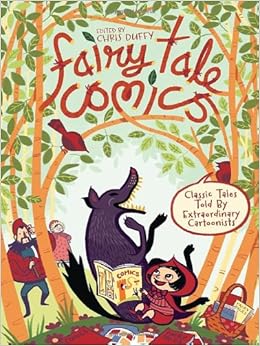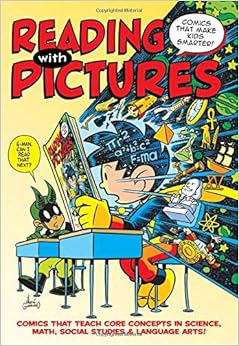
Opening lines: Once upon a time there was a poor little girl named Emma who lived in a poor little town where everyone was hungry and spent their days dreaming of sweet porridge."
This book has seventeen fairy tales, each illustrated in graphic novel form by a different artist. Here you will find well-known standards like "Little Red Riding Hood" (adapted by Gigi D.G.); "Snow White" (adapted by Jaime Hernandez), "Rapunzel" (adapted by Raina Telgemeier) and others. There are also some tales that might be unfamiliar to you. I particularly liked "The Prince and the Tortoise" (adapted by Ramona Fradon and Chris Duffy), "Give Me the Shudders" (adapted by David Mazzucchelli) and "Azzolino's Story Without End" (adapted by Chris Thompson).
I can't say every single story in here will be to your taste, but the vast majority of them take you quickly into the world to the fairy tale and illustrate the stories in a way that is compelling, funny, and faithful.
The age level for this one is a bit tricky. It is far easier to read aloud a picture book than a graphic novel (though it can be done), and there are some visual puns that the littlest kids won't get -- but I am guessing tht there are some stories in here that would be well-suited to kindergarten or first graders, and other stories that would grab older students in third or fourth grade. Middle school and high school students might be able to use it as a reference (I remember asking my drama students to present a folk tale or fairy tale and being surprised how unfamiliar they were with the genre.)
This is a beautiful, silly, and sometimes just-a-tiny-bit-scary book and worth picking up.
Josh Elder (2014) Reading with Pictures: Comics that Make Kids Smarter. Kansas City: Andrews McMeel Publishing

Opening lines: "Fifteen years ago I began teaching high school and self-publishing comics at around the same time" (From Gene Yang's Forward.)
It is kind of a paradox. We learn so much from reading stories, without even working at it. But when stories are written to try to teach us something, we sense the inauthenticity and the lack of faithfulness to the story and we reject the teaching.
This book began with a cool idea -- use the graphic novels format, which kids enjoy so much, to engage kids in school subject areas. However, each piece in this collection has to make a decision about where in the continuum from being mainly about the story to being mainly about the content being taught. And where they come down on that line determines whether each story works or doesn't.
The first story in the collection, for example, "G-Man: Reign of the Robo-Teachers" is a fun little story of what happens when robots take over the teaching duties in a school and the kids hack into their operating system. It is a great story with colorful and interesting art. I doubt there is much academic content to learn from this one, though. The very next story, "The Power of Print" reads like a dull filmstrip about how humans devleoped writing. Lots to learn here, but nothing like an engaging story, particularly with lines like "Writing has allowed for the development of society -- would we have cities and governments without a written language?" The artwork, in evenly-spaced panels and consisting of a subdued wash of color does little to grab us either. Most of the stories fall somewhere in the middle, as in the story of "Albert the Alien" which uses a class scenario with a foreign exchange student from another planet to teach about idioms and literalism for language arts class.
The other issue for teachers with this collection is that, even though it has 16 different stories covering language arts, science, mathematics, and social studies, that only works out to three or four stories per subject. So while it is a good book for the back of a third through sixth grade classroom, it is not the sort of book that would likely be used to teach a lesson or a unit.
Lendler, Ian; Giallongo, Zack (2015) The Stratford Zoo Midnight Revue Presents Romeo and Juliet. New York: First Second

Opening lines: Banner: Big Bill Shakespeare's Romeo and Juliet: A most excellent and woeful tragedy! A tale of ancient grudges and the true love of good friends.
Little Monkey: "Mom, what's a woeful tragedy?."
The first book in this series, an adaptation of Macbeth, was hilarious. This one is at least as good and maybe better. The zoo animals of the Stratford Zoo are once again putting on a play. This time it is about Romeo the Rooster, prince of the petting zoo, who meets Juliet, a bear from the woods, and they decide they want to be friends. Unfortunately, bears can never be part of the petting zoo, and if creatures from the petting zoo come to the forest, they will be eaten alive. Star-crossed lovers indeed.
Lendler and Giallongo handle the violence in the play in a way that uses humor to avoid anything that might be troubling. For example, after the death of Mercutio, Romeo grabs a sword and flies at Tybolt the fox, but at that moment, two elephants arrive late for the play and as they are crossing to their seats, we miss the entire battle. The next panel shows Tybolt the fox lying on the ground with his tongue hanging out, hands clasped over his chest, holding a lily, and Romeo the Rooster standing over him with a sword saying "Whoops."
I don't know what age the book was originally intended for, but it seems to me it would work well with third grade and older. There is no offensive violence in the book, though there is a point where a donkey character is rightfully called an ass, and another point where Juliet says, "Well, this sucks." Most communities probably would not be terribly bothered by that though.
It is a great way for younger readers to tackle the story of Romeo and Juliet so they will be ready when they get to read the real thing.
No comments:
Post a Comment